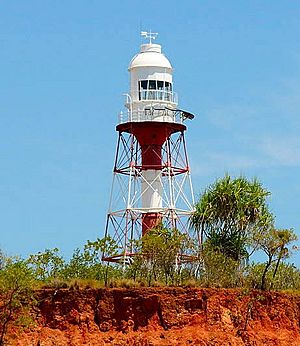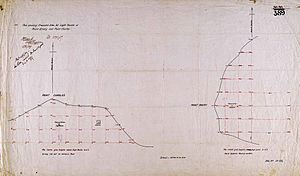Point Charles Light facts for kids
 |
|
| Point Charles Light, view from sea | |
|
|
|
| Location | Cox Peninsula Northern Territory Australia |
|---|---|
| Coordinates | 12°23′21.44″S 130°37′50.45″E / 12.3892889°S 130.6306806°E |
| Year first constructed | 1893 |
| Automated | 1933 |
| Deactivated | 1971-1974 |
| Construction | cast wrought iron skeletal tower |
| Tower shape | hexagonal tower with central cylinder, balcony and lantern |
| Markings / pattern | red tower with a horizontal white band and white lantern |
| Height | 105 feet (32 m) |
| Focal height | 128 feet (39 m) |
| Original lens | 1st order Chance Brothers dioptric |
| Intensity | 37,000 cd. |
| Range | 17 nmi (31 km; 20 mi) |
| Characteristic | Fl W 5s |
| Admiralty number | K3322 |
| NGA number | 111-9524 |
| ARLHS number | AUS-056 |
The Point Charles Light, also called the Charles Point Lighthouse, is a working lighthouse. You can find it on a piece of land sticking out into the sea, called a headland. This headland is at the very north end of the Cox Peninsula in Australia's Northern Territory. It's about 21 kilometers (13 miles) northwest of Port Darwin. This lighthouse was built in 1893, making it the oldest one in the Northern Territory.
The Story of Point Charles Lighthouse

In the 1880s, many ships crashed when trying to reach Port Darwin. Because of this, a group called the Marine Board suggested in 1888 that lighthouses were needed. They wanted lights at Capes Fourcroy and Don, and at Points Emery and Charles.
Money was raised to build the lighthouses at Point Charles and Point Emery. A company from England called Chance Bros won the job to build the Point Charles light. They packed the lighthouse into crates and sent it to Adelaide in 1891.
The lighthouse parts then traveled by ship to Port Darwin. From there, another ship took them to Point Charles. Building the lighthouse started in 1892. It was supposed to be finished by September 1892. However, the lighthouse parts were rusty when they arrived, which caused a delay. The lighthouse officially opened on February 1, 1893. Charles James Dashwood, who was the Government Resident of the Northern Territory at the time, opened it.
The lighthouse tower is 92 feet (28 meters) tall and made of wrought iron. It has a central tube that is almost 2 meters (6.6 feet) wide. Inside this tube, a spiral staircase leads up to the lantern room at the top.
The lantern held a special revolving lens that helped the light shine far. At first, the light came from a vaporized kerosene burner. This light was very bright, about 100,000 cd. In 1894, these burners were changed because insects were causing problems. The lighthouse originally flashed a white light every 30 seconds. It also had red and green sections to help ships know where they were. The light was 36 meters (118 feet) above sea level and could be seen for 17 nautical miles (31 kilometers), even from Darwin.
Several homes for the lighthouse keepers were also built. These homes were made of galvanized iron with wooden floors and verandahs (porches).
Modern Changes and Automation
In 1932, a decision was made to change the light source. They decided to use acetylene gas and make the lighthouse work by itself. The lighthouse became automated in 1933, meaning no keepers were needed anymore. It continued to work automatically until 1971.
In 1965, a company called Radio Australia put up very tall radio masts nearby. These masts had powerful lights on top that could be seen for 22 nautical miles (41 kilometers). Because of these new bright lights, the lighthouse was no longer as important. In 1971, the lighthouse light was turned off. The tower then became a day marker, meaning it was used to guide ships during the day without a light.
However, this change did not last long. On Christmas Eve in 1974, a huge storm called Cyclone Tracy hit the area. It caused a lot of damage to the Radio Australia masts. The lighthouse, though, stayed almost completely fine! Within a month, a small, low-powered lamp was put back in the lighthouse, running on batteries.
In 1986, the lighthouse was listed on the Register of the National Estate. This list no longer exists, but it showed the lighthouse was important.
In 1982, backup diesel generators were installed. In July 1982, the tower was fully powered by electricity. A very powerful 1,000,000 cd lamp was put in. Later, this was replaced with a less powerful but cheaper solar-powered light.
Today, the light uses a 12-volt halogen lamp powered by the sun. It has an intensity of 37,000 cd. The light flashes white every five seconds. It can still be seen for 17 nautical miles (31 kilometers).
How to Visit and Who Runs It
The Radio Australia facility closed in July 1997. After that, the land was leased to a group called Christian Voice Broadcasting Service (CVC). In 2003, CVC fenced off the area, which stopped people from visiting the lighthouse.
CVC's lease ended in June 2010. As of November 2010, you can now get to the lighthouse by road. This is possible because of agreements with the local Indigenous land owners.
The Australian Maritime Safety Authority operates the light. They usually get to the site by helicopter.



